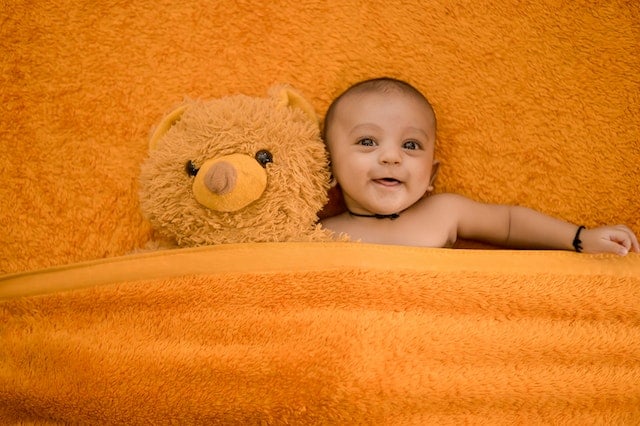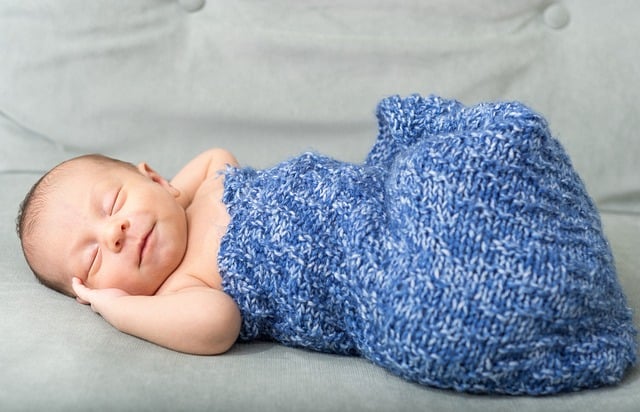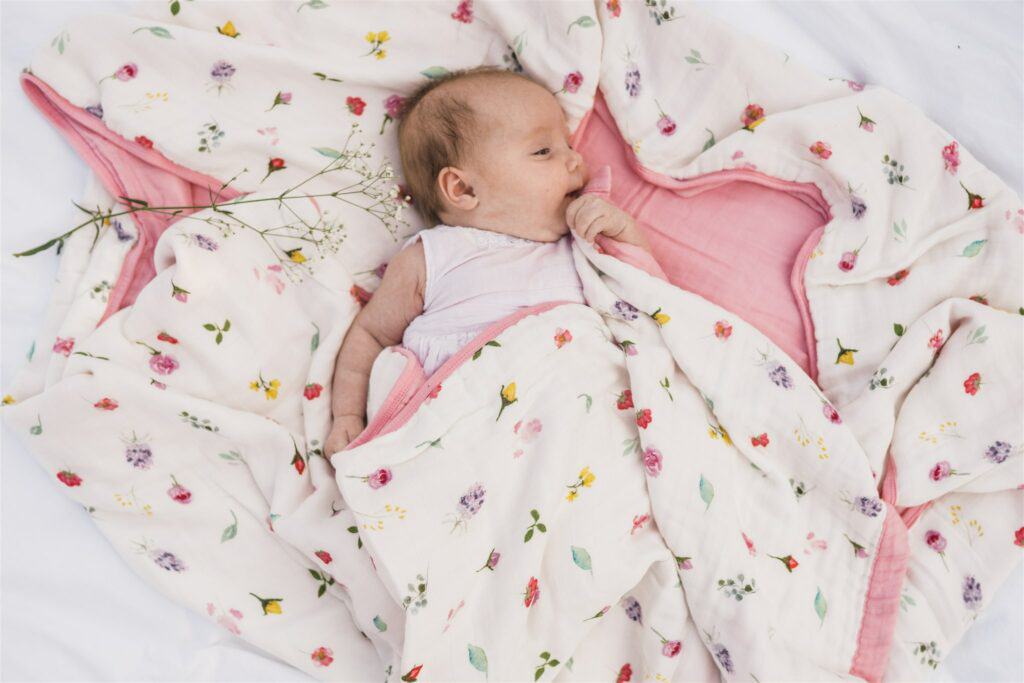Receiving blankets and swaddle blankets are two of the most commonly used baby items that parents use to keep their newborns warm and cozy. While both serve the same purpose, they differ in terms of design, material, and usage. Understanding the differences between these two types of blankets can help parents make informed decisions when it comes to selecting the best option for their little ones.
Receiving blankets are typically made of lightweight, breathable materials such as cotton or muslin. They are designed to be versatile and used for a variety of purposes, such as swaddling, burping, and wiping up spills. Swaddle blankets, on the other hand, are specifically designed for swaddling a newborn. They are usually made of stretchy, soft fabrics that allow for a snug and secure fit around the baby’s body.
Key Takeaways
- Receiving blankets are versatile and can be used for multiple purposes, while swaddle blankets are specifically designed for swaddling.
- Receiving blankets are usually made of lightweight, breathable materials, while swaddle blankets are typically made of stretchy, soft fabrics.
- Understanding the differences between receiving blankets and swaddle blankets can help parents make informed decisions when selecting the best option for their newborns.
Understanding Receiving Blankets

A receiving blanket is a thin, lightweight, and versatile blanket that is typically rectangular in shape and designed to cover newborns. It is one of the most essential items for new parents, and it serves multiple purposes.
Receiving blankets are commonly used as a cover for a newborn, providing warmth and comfort. They can also be used as a burp cloth or a nursing cover. Hospitals often provide receiving blankets to new parents to use during their stay.
The design of a receiving blanket can vary, with a variety of prints and materials available. Muslin receiving blankets are a popular choice due to their softness and durability. Knit receiving blankets are also available, and they are stretchy and comfortable for infants.
Receiving blankets are also a great backup for baby blankets, and they can be used as a play mat or tummy time mat. They can also be used as a barrier on changing tables or as a stroller cover.
Cleaning a receiving blanket is easy, and they can be washed in a regular laundry cycle. They are also compact and easy to store in a diaper bag.
Overall, receiving blankets are a must-have item for newborns and infants. They offer comfort, security, and versatility for parents and babies alike.
Exploring Swaddle Blankets

Swaddle blankets are a popular choice for parents who want to wrap their newborns in a snug and secure cocoon. Swaddling is a technique that involves wrapping a baby in a thin blanket, mimicking the feeling of being in the womb. It provides a sense of security and comfort to the baby, helping them sleep better and longer.
Swaddle blankets come in a variety of materials, including muslin, flannel, and cotton. Muslin is a popular choice for its lightweight and breathable properties, making it ideal for warmer climates. Flannel and cotton, on the other hand, provide warmth and softness, making them perfect for cooler weather.
Swaddle blankets are designed to be versatile and can be used for a variety of purposes. They can be used as a cover for nursing in public, a tummy time mat, a barrier for changing tables, and even as a play mat. Some swaddle blankets come with winged sides or closures like snaps or velcro, making it easier to wrap the baby securely.
Swaddle blankets are also a popular item to include in a baby registry or as a gift for new parents. They come in a variety of designs and prints, making them a fun and stylish accessory for babies. Some swaddle blankets even come in packs, providing a backup in case one gets dirty or lost.
It’s important to note that while swaddle blankets can provide comfort and security to newborns, they should be used safely and in accordance with safe sleep practices. The American Academy of Pediatrics recommends that parents stop swaddling their babies when they show signs of rolling over, which usually happens around 2-3 months old. Additionally, swaddle blankets should be made of breathable material to reduce the risk of suffocation and Sudden Infant Death Syndrome (SIDS).
Overall, swaddle blankets are a great option for parents who want to provide comfort and security to their newborns. They come in a variety of materials, designs, and sizes, making them a versatile and practical item for any diaper bag or nursery.
Comparing Receiving Blankets and Swaddle Blankets

When it comes to wrapping up newborns for warmth and comfort, parents have two main options: receiving blankets and swaddle blankets. Both serve a similar purpose, but there are some differences to consider.
1. Size and Shape
Receiving blankets are typically rectangular or square in shape and measure around 30 inches by 30 inches. They are made from a variety of materials, including muslin, flannel, and cotton, and can be used for a variety of purposes beyond swaddling, such as a burp cloth or nursing cover.
Swaddle blankets, on the other hand, are specifically designed for swaddling and are usually larger than receiving blankets, measuring around 40 inches by 40 inches. They often have winged sides or closures like velcro or snaps to help keep the blanket securely wrapped around the baby.
2. Material and Versatility
Receiving blankets come in a variety of materials and designs, making them a versatile option for parents. They can be used as a thin blanket for warmer climates or as an extra layer for colder weather. They are also lightweight and easy to pack in a diaper bag for on-the-go use.
Swaddle blankets are often made from breathable materials, such as muslin or jersey knit, to prevent overheating and promote safe sleep practices. They are designed to keep the baby snug and secure, which can be especially helpful for infants who have trouble sleeping.
3. Durability and Cost
Receiving blankets are often less expensive than swaddle blankets and can be purchased in packs. They are also durable and can withstand frequent washing.
Swaddle blankets, on the other hand, are often a bit more expensive due to their specific design and materials. However, they are often considered a worthwhile investment for parents who want a safe and secure option for swaddling their newborn.
Overall, both receiving blankets and swaddle blankets have their benefits and drawbacks. Parents should consider their specific needs and preferences when choosing between the two.
Frequently Asked Questions
What is the difference between receiving blankets and swaddle blankets?
Receiving blankets are typically larger than swaddle blankets and are used to wrap newborns or cover them while sleeping or breastfeeding. Swaddle blankets, on the other hand, are specifically designed to tightly wrap newborns to provide a sense of security and comfort.
Are receiving blankets safe for babies to sleep with?
Receiving blankets can be safe for babies to sleep with as long as they are used properly. It is important to make sure the blanket is not too loose or too tight and that the baby’s face is not covered. It is also important to follow safe sleep guidelines, such as placing the baby on their back to sleep and avoiding loose bedding.
What are the benefits of using a receiving blanket?
Using a receiving blanket can provide warmth and comfort for a newborn, as well as provide a barrier between the baby and any surfaces they are placed on. Receiving blankets can also be used as a nursing cover or burp cloth.
What are the benefits of using a swaddle blanket?
Swaddling can help newborns feel secure and calm, and can also prevent them from startling themselves awake. Swaddle blankets can also help regulate a baby’s body temperature and reduce the risk of Sudden Infant Death Syndrome (SIDS) when used properly.
What should I consider when choosing between a receiving blanket and a swaddle blanket?
When choosing between a receiving blanket and a swaddle blanket, it is important to consider the baby’s age, size, and developmental stage. Newborns may benefit more from swaddling, while older babies may prefer the freedom of movement provided by a receiving blanket. It is also important to consider the material and size of the blanket, as well as any safety guidelines.
Why is swaddling not recommended anymore?
Swaddling is still recommended by many healthcare professionals, but there are some concerns about the potential for hip dysplasia if a baby’s legs are wrapped too tightly. It is also important to make sure the baby’s face is not covered and that the blanket is not too loose or too tight. As with any baby product, it is important to follow safe sleep guidelines and use the product as directed.

Iesha is a loving mother of 2 beautiful children. She’s an active parent who enjoys indoor and outdoor adventures with her family. Her mission is to share practical and realistic parenting advice to help the parenting community becoming stronger.
